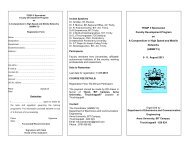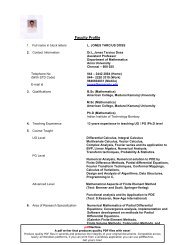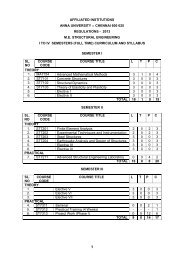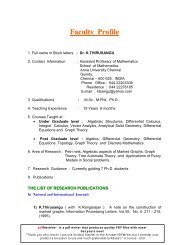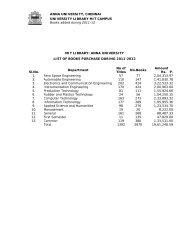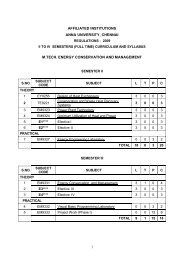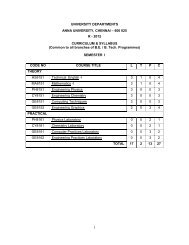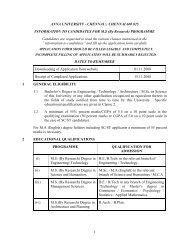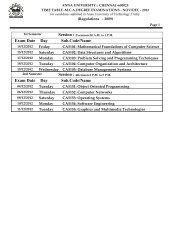The Societal Framework Enshrined in the Atharva ... - Anna University
The Societal Framework Enshrined in the Atharva ... - Anna University
The Societal Framework Enshrined in the Atharva ... - Anna University
You also want an ePaper? Increase the reach of your titles
YUMPU automatically turns print PDFs into web optimized ePapers that Google loves.
<strong>The</strong> <strong>Societal</strong> <strong>Framework</strong> <strong>Enshr<strong>in</strong>ed</strong> <strong>in</strong> <strong>the</strong> <strong>Atharva</strong> Veda<br />
Authors<br />
Dr. A Kalanidhi<br />
Vice-Chancellor<br />
<strong>Anna</strong> <strong>University</strong><br />
Chennai – 600 025, India<br />
e-mail : vc@annauniv.edu<br />
and<br />
Dr. T V Gopal<br />
Assistant Professor<br />
School of Computer Science and Eng<strong>in</strong>eer<strong>in</strong>g<br />
<strong>Anna</strong> <strong>University</strong><br />
Chennai – 600 025, India<br />
e-mail : gopal@annauniv.edu<br />
Presented at: Workshop on “Brahmanas and Aranyakas”, Bangalore, May 2002.<br />
Abstract<br />
<strong>The</strong> <strong>Atharva</strong> Veda has been looked upon with a suspicious eye. Even dur<strong>in</strong>g <strong>the</strong> vedic<br />
period this veda was not readily accepted by <strong>the</strong> Aryan m<strong>in</strong>d. <strong>The</strong> authors f<strong>in</strong>d that<br />
<strong>Atharva</strong> Veda is very apt for research as it dwells extensively on <strong>the</strong> Indo-Aryan culture.<br />
Vedic Aryans were perhaps a slightly ref<strong>in</strong>ed form of <strong>the</strong> barbarians. <strong>The</strong> materialistic<br />
thoughts and outlook f<strong>in</strong>d expression <strong>in</strong> <strong>the</strong> magico-religious beliefs and practices of<br />
natural religion. <strong>The</strong> <strong>Atharva</strong> Veda stands out from <strong>the</strong> o<strong>the</strong>r three vedas as its Samhita<br />
does not conta<strong>in</strong> ideas about sacrifice. <strong>Atharva</strong> Veda is popularly perceived as <strong>the</strong> veda of<br />
spells, charms and <strong>in</strong>cantations. Its ma<strong>in</strong> promise is to fulfil all worldly desires of human<br />
be<strong>in</strong>gs is seldom studied. <strong>The</strong> authors exam<strong>in</strong>e <strong>the</strong> societal framework enshr<strong>in</strong>ed <strong>in</strong> <strong>the</strong><br />
<strong>Atharva</strong> Veda.<br />
1. Introduction<br />
<strong>The</strong>re are four parts for any veda. <strong>The</strong>y are :<br />
1. Samhita : <strong>The</strong> verses or hymns or manthras of <strong>the</strong> veda.<br />
2. Brahmana : <strong>The</strong> correspond<strong>in</strong>g rituals for <strong>the</strong> priests. <strong>The</strong>y orig<strong>in</strong>ated<br />
from <strong>the</strong> scholastic controversies or op<strong>in</strong>ions of <strong>the</strong> rishis.<br />
<strong>The</strong>y are always open to new <strong>in</strong>terpretations.<br />
3. Aranyaka : <strong>The</strong> correspond<strong>in</strong>g commentary designed to prepare a pupil for<br />
a secluded life.<br />
4. Upanishad<br />
<strong>The</strong> <strong>Atharva</strong> Veda has n<strong>in</strong>e recensions. <strong>The</strong>y are Paippalada, Tauda, Mauda, Saunaka,<br />
Jajala, Jalada, Brahmavada, Devadars<strong>in</strong> and Charanavaidya. Currently <strong>the</strong> <strong>Atharva</strong>
Samhita that is available is <strong>the</strong> “Paippalada Recension”. This recension has about 750<br />
hymns and 6000 verses.<br />
All <strong>the</strong> recensions of <strong>Atharva</strong> Veda Samhita mention <strong>Atharva</strong>-Angirasa as <strong>the</strong> name of<br />
this veda. <strong>The</strong> Angirasa part dwells <strong>in</strong> witch craft and sorcery or black magic. Sage<br />
Bhrigu also f<strong>in</strong>ds a prom<strong>in</strong>ent mention as ‘Bhrigangirasa’. It is widely believed that<br />
sorcery needs to be eschewed and only <strong>Atharva</strong> is normally mention <strong>in</strong> <strong>the</strong> name of <strong>the</strong><br />
Veda Samhita. <strong>The</strong> o<strong>the</strong>r parts of this veda also follow <strong>the</strong> same methodology.<br />
<strong>The</strong> basic tenets enshr<strong>in</strong>ed <strong>in</strong> <strong>the</strong> vedic religion are :<br />
<strong>The</strong> worship of Gods largely represent<strong>in</strong>g <strong>the</strong> personification of <strong>the</strong> powers of<br />
nature.<br />
<strong>The</strong> vedic hymns are replete with myths and sacrifices.<br />
Poly<strong>the</strong>ism and Pan<strong>the</strong>ism are dom<strong>in</strong>ant features.<br />
<strong>The</strong> Vedic religion guides one to w<strong>in</strong> <strong>the</strong> favour of chosen god or gods.<br />
<strong>The</strong> worship of Gods is through correspond<strong>in</strong>g rituals.<br />
Vedic Sacrifice is supplicatory and is meant to obta<strong>in</strong> benefits <strong>in</strong> future life.<br />
Vedic Sacrifice can be simple as well as complicated.<br />
Faith <strong>in</strong> <strong>the</strong> gods is <strong>the</strong> cornerstone of <strong>the</strong> Vedic religion.<br />
<strong>The</strong> sacrificer ga<strong>in</strong>s <strong>in</strong> <strong>the</strong> present life by his gifts to <strong>the</strong> priests.<br />
<strong>The</strong> idea of s<strong>in</strong> is clearly def<strong>in</strong>ed.<br />
Gopatha Brahmana is <strong>the</strong> only Brahamana available. No Aranayaka is available today.<br />
<strong>The</strong> o<strong>the</strong>r pert<strong>in</strong>ent scriptures correspond<strong>in</strong>g to ‘<strong>Atharva</strong> Veda’ [AV] are mentioned<br />
below.<br />
1.1 Upanishads<br />
1. <strong>Atharva</strong>na Upanishad or Mantra Upanishad of <strong>Atharva</strong>veda or Mundaka<br />
Upanishad<br />
2. Pranava Upanishad (<strong>in</strong> <strong>the</strong> Gopatha Brahmana)<br />
3. Gayatri Upanishad (Gopatha Brahamana I, 32-33)<br />
4. Prashna Upanishad<br />
5. Brahma Upanishad<br />
6. Garbha Upanishad<br />
7. Chulika Upanishad<br />
8. Mandukya Upanishad<br />
9. Brahmab<strong>in</strong>du Upanishad<br />
10. Nadab<strong>in</strong>du Upanishad<br />
11. Dhyanab<strong>in</strong>du Upanishad<br />
12. Amritab<strong>in</strong>du Upanishad<br />
13. <strong>Atharva</strong>shiras Upanishad<br />
14. <strong>Atharva</strong>shikha Upanishad<br />
15. Kaivalya Upanishad
<strong>The</strong>re are of course many upanishads and <strong>in</strong> some lists even texts like <strong>the</strong> Kena and<br />
Mahanarayana are attached to <strong>the</strong> AV. Dhanurveda is <strong>the</strong> Upaveda of AV.<br />
1.2 Lakshana Granthas and Shikshas<br />
1. Panchapatalika<br />
2. Dantyoshthavidhi<br />
3. Shaunakiya Chaturadhyayika aka Kautsa Vyakarana<br />
4. Brihatsarvanukramani<br />
5. <strong>Atharva</strong>-Pratisakhya<br />
6. Manduki Shiksha<br />
1.3 Kalpasutras<br />
1. Vaitana Srautasutra<br />
2. <strong>Atharva</strong>paraschittani<br />
3. Kausika Grhyasutra<br />
4. Paith<strong>in</strong>asi<br />
5. Angirasakalpa<br />
6. Santikalpa<br />
7. Saunaka Dharmasutra<br />
8. Kasyapa Dharmasutra<br />
9. Paith<strong>in</strong>asi Dharmasutra<br />
1.4 Jyotisha and Parishishta Literature<br />
1. <strong>Atharva</strong>na Jyotisha<br />
2. <strong>the</strong>re is a big collection of 72 Parishishtas which comprise diverse topics like <strong>the</strong><br />
Kautsavya Nighantu, Charanavyuya, <strong>the</strong> Uttamapatala and o<strong>the</strong>r appendices on<br />
Royal ceremonies, religious rites and so on.<br />
<strong>The</strong> <strong>in</strong>terpretation on <strong>the</strong> <strong>Atharva</strong> Brahmanam presented <strong>in</strong> this paper preserves <strong>the</strong><br />
sanctity of vedic religion.<br />
2. <strong>The</strong> <strong>Societal</strong> <strong>Framework</strong><br />
<strong>The</strong> societal framework detailed <strong>in</strong> <strong>the</strong> <strong>Atharva</strong> Veda [AV] is discussed <strong>in</strong> this section.<br />
2.1 Home and Society<br />
Five great Aryan tribes namely Turvasas, Yadus, Anus, Druhyus and Purus are vividly<br />
discussed. AV adheres <strong>the</strong> four fold classification namely Brahm<strong>in</strong>, Kshatriya, Vysya<br />
and Sudra. AV focuses on <strong>the</strong> aims and duties of Kshatriyas. Cattle rear<strong>in</strong>g and<br />
agriculture are <strong>the</strong> ma<strong>in</strong> occupations. <strong>The</strong> home is a ‘sala’ replete with necessary ear<strong>the</strong>n<br />
vessels, wooden seats and mats, mortar and <strong>the</strong> like. <strong>The</strong> fire was eternally lit <strong>in</strong> <strong>the</strong> sala.
<strong>The</strong>re were weavers and color garments were worn. Metallurgists, Chariot-builders and<br />
Charioteers enjoyed a high position <strong>in</strong> <strong>the</strong> society. Boats were used to transport tree<br />
trunks. <strong>The</strong> standard of morality was very high and immoral acts were severely punished.<br />
Gambl<strong>in</strong>g was <strong>the</strong> ma<strong>in</strong> enterta<strong>in</strong>ment. Flesh, w<strong>in</strong>e, women and chariot rac<strong>in</strong>g were<br />
predom<strong>in</strong>ant.<br />
2.2 Woman<br />
<strong>The</strong> birth of a daughter was deprecated. A ‘ten month old’ son was <strong>the</strong> persistent demand.<br />
Woman and <strong>the</strong> various stages of womanhood are described more naturally <strong>in</strong> AV.<br />
2.3 K<strong>in</strong>gship<br />
K<strong>in</strong>gship was deemed as a solution to prevent anarchy. ‘Indra’ was considered a typical<br />
k<strong>in</strong>g. <strong>The</strong> notion that ‘Indra’ is a post f<strong>in</strong>ds eveidence <strong>in</strong> AV. <strong>The</strong> k<strong>in</strong>g was elected by <strong>the</strong><br />
people<strong>in</strong> accordance with Varuna. Varuna was ak<strong>in</strong> to <strong>the</strong> modern day “electoral officer”.<br />
<strong>The</strong> k<strong>in</strong>g had a specially decorated throne. ‘Samiti’ was <strong>the</strong> national assembly of <strong>the</strong><br />
whole people. Sabha or Narista is ano<strong>the</strong>r sister assembly. Narista was more social than<br />
political. Vidhata is ano<strong>the</strong>r <strong>in</strong>stitution that deals with civil, military and religious<br />
functions.<br />
2.4 Disease and Medic<strong>in</strong>e<br />
More than hundred diseases <strong>in</strong>tended to be cured by charms and prescribed practices are<br />
discussed <strong>in</strong> AV. Charaka and Susrutha Samhita can be traced to AV. Even <strong>the</strong> modern<br />
day Reiki has its roots <strong>in</strong> AV. S<strong>in</strong>ful persons were believed to be punished by <strong>the</strong> Gods<br />
with various diseases. Herbs are also detailed along with <strong>the</strong> diseases <strong>the</strong>y cure. It is<br />
<strong>in</strong>terest<strong>in</strong>g to observe that <strong>the</strong> entire herb needs to be consumed by <strong>the</strong> patient. This<br />
notion is not <strong>in</strong> accordance with <strong>the</strong> modern patent system where<strong>in</strong> a unique compound of<br />
<strong>the</strong> herb is patented.<br />
Human Anatomy, Physiology and Embryology are wonderfully described <strong>in</strong> AV. This is<br />
quite astonish<strong>in</strong>g consider<strong>in</strong>g <strong>the</strong> times <strong>in</strong> which <strong>the</strong>se details were documented.<br />
2.5 Magic and Witchcraft<br />
This aspect of AV is most widely known. <strong>The</strong> defensive magic is to ward of evil and is<br />
discussed as <strong>the</strong> <strong>Atharva</strong> aspect of magic. <strong>The</strong> offensive magic or witchcraft that is meant<br />
to <strong>in</strong>flict evil on o<strong>the</strong>rs is discussed as <strong>the</strong> Angirasa aspect of magic. Charms, Talisman<br />
and Amulets are vividly discussed with purposes clearly described. <strong>The</strong> rules for us<strong>in</strong>g<br />
magic are also described. <strong>The</strong>se rules are fur<strong>the</strong>r elucidated <strong>in</strong> various “agamas’<br />
confirm<strong>in</strong>g to <strong>the</strong> tenets of <strong>the</strong> religion discussed <strong>in</strong> <strong>the</strong> four vedas.
2.6 Cosmology and Cosmogony<br />
Heaven and Earth are deemed parents of all creation. <strong>The</strong> abodes of pr<strong>in</strong>cipal gods are<br />
detailed. <strong>The</strong> year was of 360 days and 12 months. Except Earth, Sun, Moon and Rahu<br />
<strong>the</strong> o<strong>the</strong>r planets were unknown. Six seasons are clearly mentioned. 27 fixed stars are<br />
identified. Sketchy notions of cosmogony – <strong>the</strong> birth and growth of <strong>the</strong> Universe are<br />
found <strong>in</strong> AV. A hierarchy of Gods is described with Earth as <strong>the</strong> mo<strong>the</strong>r. <strong>The</strong> idea of s<strong>in</strong><br />
is quite clear. It was believed that s<strong>in</strong> could float away with appropriate appeasement of a<br />
relevant god.<br />
2.7 Eschatology<br />
Funeral practices for <strong>the</strong> disposal of <strong>the</strong> dead are clearly described <strong>in</strong> AV. <strong>The</strong> notions of<br />
life after death, <strong>the</strong> ideas of heaven and hell are detailed.<br />
2.8 Myths and Legends<br />
AV is relatively barren on myths and legends. It presupposes <strong>the</strong> existence of myths <strong>in</strong><br />
o<strong>the</strong>r vedas. <strong>The</strong> notion of soul and its journey after death are detailed. <strong>The</strong> notions of<br />
gett<strong>in</strong>g desired progeny are also described.<br />
AV Brahmana also has a host of rituals vividly described. <strong>The</strong> authors have briefly<br />
mentioned <strong>the</strong> aspects of <strong>the</strong> societal framework deemed pert<strong>in</strong>ent for <strong>the</strong>ir work related<br />
to re-birth.<br />
3. Magic of <strong>Atharva</strong> Veda and Science<br />
“A new scientific truth does not triumph by conv<strong>in</strong>c<strong>in</strong>g its opponents and mak<strong>in</strong>g <strong>the</strong>m<br />
see <strong>the</strong> light; but ra<strong>the</strong>r because its opponents eventually die and a new generation grows<br />
up that is familiar with it.” - Max Planck<br />
<strong>The</strong> energy beh<strong>in</strong>d <strong>the</strong> magic described <strong>in</strong> <strong>the</strong> AV Brahmana pivots on <strong>the</strong> existence of<br />
<strong>the</strong> subtle force called “kundal<strong>in</strong>i” <strong>in</strong> every human be<strong>in</strong>g. This force can be awakened by<br />
practic<strong>in</strong>g Pranayama or by chant<strong>in</strong>g <strong>the</strong> mantras or meditat<strong>in</strong>g us<strong>in</strong>g mantras. <strong>The</strong>re<br />
appears to be a clear understand<strong>in</strong>g of <strong>the</strong> occult forces <strong>in</strong> <strong>the</strong> AV Brahmana. However,<br />
<strong>the</strong>y are qua<strong>in</strong>t and need a careful <strong>in</strong>terpretation.<br />
From physics to metaphysics is a study currently be<strong>in</strong>g carried out by <strong>the</strong> authors.
4. Conclusions<br />
Rig, Yajur and Sama veda are often referred to as ‘Traividyas’. Beyond doubt <strong>the</strong>re<br />
existed a rivalry between <strong>the</strong>se vidyas and <strong>the</strong> <strong>Atharva</strong> Veda. This may be due <strong>the</strong><br />
<strong>in</strong>difference of AV to vedic sacrifices. Also, AV dwells more on <strong>the</strong> lower deities<br />
mentioned <strong>in</strong> <strong>the</strong> o<strong>the</strong>r vedas. Over several centuries <strong>the</strong>se differences are smoo<strong>the</strong>ned<br />
and AV is recognized on par with any of <strong>the</strong> o<strong>the</strong>r vedas.<br />
In this paper <strong>the</strong> authors aver that <strong>the</strong>re is no need for any special societal framework for<br />
explor<strong>in</strong>g <strong>the</strong> scientific aspects mentioned <strong>in</strong> <strong>the</strong> AV. Thus, <strong>the</strong> study of AV Samhita<br />
Brahmana is limited to serve this purpose. Many more <strong>in</strong>terest<strong>in</strong>g truths about vedic<br />
religion and society may be found by fur<strong>the</strong>r study <strong>in</strong> this direction of re-<strong>in</strong>terpretation.<br />
5. References<br />
1. Bibek Debroy and Dipavali Debroy, ‘<strong>The</strong> <strong>Atharva</strong> Veda’, Books for All, New<br />
Delhi, 1994.<br />
2. John White and Stanley Krippner, ‘Future Science’, Anchor Press, USA, 1977.<br />
3. Kalanidhi A and Gopal T V, ‘<strong>The</strong> Impact of Birth, Death and Re-Birth Cycle on<br />
Progeny’, Proceed<strong>in</strong>gs of <strong>the</strong> WAVES India Conference, Vol. II, SriSailam,<br />
December 2001, pp106-117.<br />
4. Kalanidhi A and Gopal T V, ‘Vedic Mantras are Superstr<strong>in</strong>gs’, To be presented at<br />
<strong>the</strong> WAVES International Conference, USA, July 2002.<br />
5. Karambelkar V W, ‘<strong>The</strong> <strong>Atharva</strong>vedic Civilization’, Nagpur <strong>University</strong>, 1959.<br />
6. Naaga Bharathi, ‘H<strong>in</strong>du Vedic Science of Progeny’, Bharathiya Vidya Bhavan,<br />
Mumbai, 1999.<br />
7. Uma Gupta, ‘Materialism <strong>in</strong> <strong>the</strong> Vedas’, Classical Publish<strong>in</strong>g Co., New Delhi,<br />
1987.



